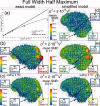Sensitivity of beamformer source analysis to deficiencies in forward modeling
- PMID: 21086549
- PMCID: PMC6871065
- DOI: 10.1002/hbm.20986
Sensitivity of beamformer source analysis to deficiencies in forward modeling
Abstract
Beamforming approaches have recently been developed for the field of electroencephalography (EEG) and magnetoencephalography (MEG) source analysis and opened up new applications within various fields of neuroscience. While the number of beamformer applications thus increases fast-paced, fundamental methodological considerations, especially the dependence of beamformer performance on leadfield accuracy, is still quite unclear. In this article, we present a systematic study on the influence of improper volume conductor modeling on the source reconstruction performance of an EEG-data based synthetic aperture magnetometry (SAM) beamforming approach. A finite element model of a human head is derived from multimodal MR images and serves as a realistic volume conductor model. By means of a theoretical analysis followed by a series of computer simulations insight is gained into beamformer performance with respect to reconstruction errors in peak location, peak amplitude, and peak width resulting from geometry and anisotropy volume conductor misspecifications, sensor noise, and insufficient sensor coverage. We conclude that depending on source position, sensor coverage, and accuracy of the volume conductor model, localization errors up to several centimeters must be expected. As we could show that the beamformer tries to find the best fitting leadfield (least squares) with respect to its scanning space, this result can be generalized to other localization methods. More specific, amplitude, and width of the beamformer peaks significantly depend on the interaction between noise and accuracy of the volume conductor model. The beamformer can strongly profit from a high signal-to-noise ratio, but this requires a sufficiently realistic volume conductor model.
Copyright © 2010 Wiley-Liss, Inc.
Figures










Similar articles
-
The Effect of Head Model Simplification on Beamformer Source Localization.Front Neurosci. 2017 Nov 9;11:625. doi: 10.3389/fnins.2017.00625. eCollection 2017. Front Neurosci. 2017. PMID: 29209157 Free PMC article.
-
Monte Carlo simulation studies of EEG and MEG localization accuracy.Hum Brain Mapp. 2002 May;16(1):47-62. doi: 10.1002/hbm.10024. Hum Brain Mapp. 2002. PMID: 11870926 Free PMC article.
-
Localization of coherent sources by simultaneous MEG and EEG beamformer.Med Biol Eng Comput. 2013 Oct;51(10):1121-35. doi: 10.1007/s11517-013-1092-z. Epub 2013 Jun 21. Med Biol Eng Comput. 2013. PMID: 23793511
-
A guideline for head volume conductor modeling in EEG and MEG.Neuroimage. 2014 Oct 15;100:590-607. doi: 10.1016/j.neuroimage.2014.06.040. Epub 2014 Jun 25. Neuroimage. 2014. PMID: 24971512
-
Development of volume conductor and source models to localize epileptic foci.J Clin Neurophysiol. 2007 Apr;24(2):101-19. doi: 10.1097/WNP.0b013e318038fb3e. J Clin Neurophysiol. 2007. PMID: 17414966 Review.
Cited by
-
ElectroMagnetoEncephalography software: overview and integration with other EEG/MEG toolboxes.Comput Intell Neurosci. 2011;2011:861705. doi: 10.1155/2011/861705. Epub 2011 Mar 15. Comput Intell Neurosci. 2011. PMID: 21577273 Free PMC article. Review.
-
Shared Neural Mechanisms for the Prediction of Own and Partner Musical Sequences after Short-term Piano Duet Training.Front Neurosci. 2017 Apr 4;11:165. doi: 10.3389/fnins.2017.00165. eCollection 2017. Front Neurosci. 2017. PMID: 28420951 Free PMC article.
-
A Review of Issues Related to Data Acquisition and Analysis in EEG/MEG Studies.Brain Sci. 2017 May 31;7(6):58. doi: 10.3390/brainsci7060058. Brain Sci. 2017. PMID: 28561761 Free PMC article. Review.
-
IFCN-endorsed practical guidelines for clinical magnetoencephalography (MEG).Clin Neurophysiol. 2018 Aug;129(8):1720-1747. doi: 10.1016/j.clinph.2018.03.042. Epub 2018 Apr 17. Clin Neurophysiol. 2018. PMID: 29724661 Free PMC article. Review.
-
Minimum-norm cortical source estimation in layered head models is robust against skull conductivity error.Neuroimage. 2013 Nov 1;81:265-272. doi: 10.1016/j.neuroimage.2013.04.086. Epub 2013 Apr 29. Neuroimage. 2013. PMID: 23639259 Free PMC article.
References
-
- Baillet S, Mosher JC, Leahy RM ( 2001): Electromagnetic brain mapping. IEEE Signal Process Mag 18: 14–30.
-
- Bertrand O, Thévenet M, Perrin F ( 1991): 3D finite element method in brain electrical activity studies In: Nenoner J, Rajala HM, Katila T, editors. Biomagnetic Localization and 3D Modelling. Helsinki University of Technology, Helsinki, pp 154–171.
-
- Brookes MJ, Gibson AM, Hall SD, Furlong PL, Barnes GR, Hillebrand A, Singh KD, Holliday IE, Francis ST, Morris PG ( 2004): A general linear model for MEG beamformer imaging. Neuroimage 23: 936–946. - PubMed
Publication types
MeSH terms
LinkOut - more resources
Full Text Sources
Research Materials

